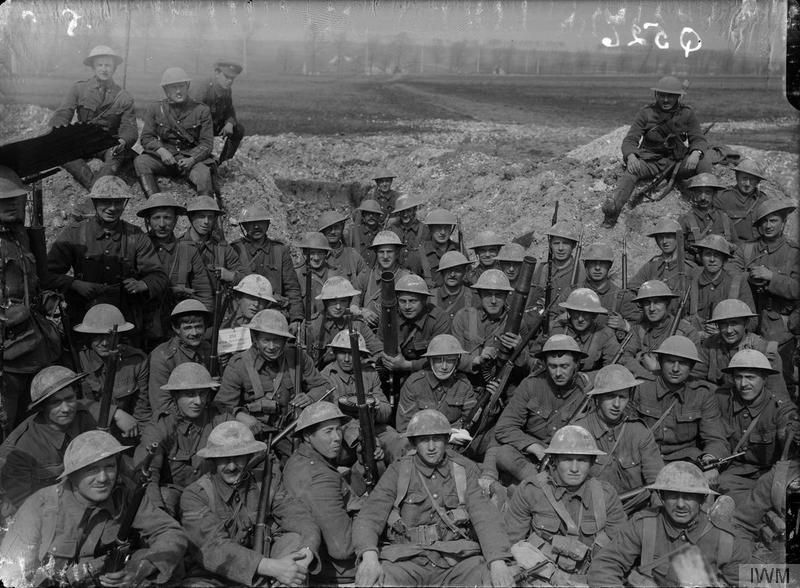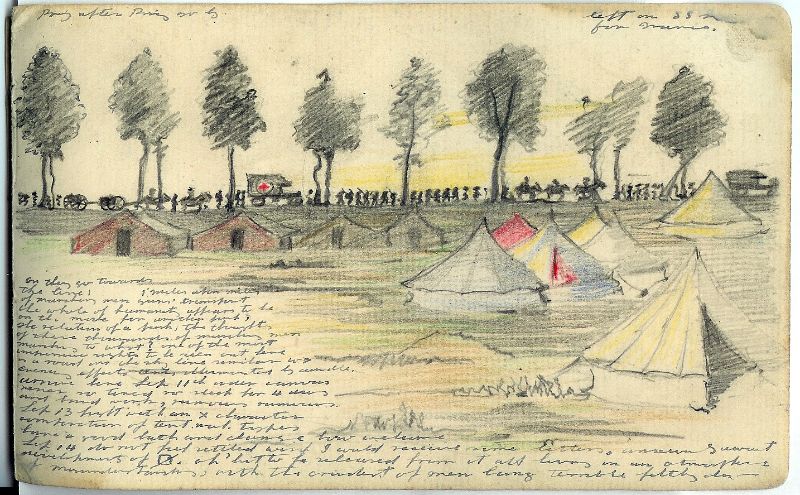55th (West Lancashire) Division Enters the Somme
The Territorial Force units of the 55th (West Lancashire) Division were reunited in January 1916 after spending 1915 mainly as reinforcements to Regular Army. The Division retrained and then held a fairly quiet sector of the front. In July, it moved to the Somme to take part in two significant actions, August's bitter, costly and unsuccessful fighting around Guillemont and, in September and more successfully, at the nearby villages of Flers and Guedecourt (to be described in the next article).
 Panorama of the Guillemont battlefield of 8/9 August 1916 looking north.
Panorama of the Guillemont battlefield of 8/9 August 1916 looking north.
Trônes Wood is on the left, the entrance to Guillemont Road CWGC Cemetery (with the tall trees) is in the centre and the spire of Guillemont Church is on the right. The road from the wood to the village runs just in front of the cemetery. On the skyline is Delville Wood. On the right, a sunken track is seen running up to the main road near the village on the right.
Photo: Ian Riley
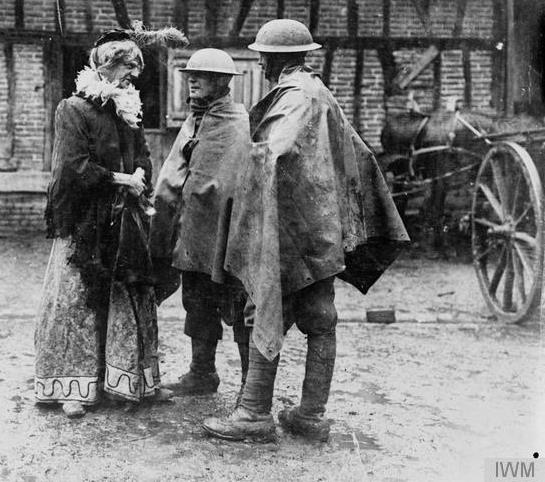 By mid-1916, the French were under desperate pressure at Verdun. To help, Britain agreed to joint action near the River Somme, the junction of the two allies. This was earlier that we anticipated committing our ‘New Armies’, not yet fully trained and with not enough heavy trench-busting artillery.
By mid-1916, the French were under desperate pressure at Verdun. To help, Britain agreed to joint action near the River Somme, the junction of the two allies. This was earlier that we anticipated committing our ‘New Armies’, not yet fully trained and with not enough heavy trench-busting artillery.
Before the Somme campaign started (1st July 1916), the 55th Division staged raids and demonstrations on their own front to the north, drawing German resources from the Somme. Battalion-level training had been patchy. The 1/9th Bn., King’s Regiment [1/9 KLR] had done none for five months though this was not general. During July, their unit tactical training increased sharply. Practice was on ‘model’ trenches using wave formations with ‘moppers up’ following and with rear waves carrying defence stores so supply would not be cut by a barrage. ‘Moppers up’ had become necessary after recent experiences when enemy emerged from dugouts behind attackers.
Late in July, the 55th Division moved to the Somme. Private William Campbell, with a Liverpool Scottish reinforcement draft, had first arrived in France in mid-July. His illustrated diary tells how they were horrified to be posted as a kilted company to 1/9 KLR rather than the ‘Scottish’. Campbell clearly considered his new comrades in a ‘khaki battalion’ as rather rough, being from places such as Crosby, Southport and Ormskirk. Such is the power of ésprit de corps or ‘unit pride’. Weeks later, after serious combat, they returned to 1/10 KLR and he was sad to leave, such are bonds quickly formed in the extremity of war. Campbell wrote:
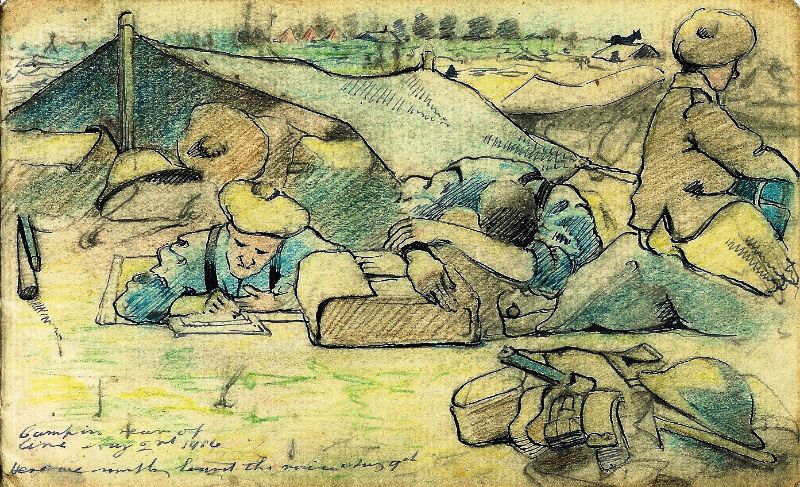 16/07/16: Whoever thought after 12 months in a good battalion, one we all cherished, we should be flung into a Battalion of …. To think that pals should be separated now on the battlefield … we are also to go over the parapet soon … I am to go over … with strangers – though they all be Englishmen.
16/07/16: Whoever thought after 12 months in a good battalion, one we all cherished, we should be flung into a Battalion of …. To think that pals should be separated now on the battlefield … we are also to go over the parapet soon … I am to go over … with strangers – though they all be Englishmen.
26/7/16: It is Hell, although we are successful*, … I am now in the most hotly contested part of the line. I simply trust in God and hope I am spared. … Somebody must be part of this tragic toll of victory, if it be myself, well I am still convinced it is necessary and right.
[Campbell Diary] [*Note: Written following the successful night attack at Bazentin]
By the end of July, there was very stiff resistance on the right at the heavily-fortified Guillemont village. Urgency meant attacks at shorter notice with less preparation. At 4:20 am on 8th August, the 55th Division attacked Guillemont. On the right, 165 Brigade attacked south of the village with some success. On the left, 164 Brigade attacked with 1/8 KLR (the ‘Liverpool Irish’ together with two companies of 1/4 LNLR) in the north and 1/4 KORLR in the division’s centre. The Lancaster battalion met uncut wire, were rallied by 2Lt Gabriel Coury of the 1/4th South Lancs, the 55th Division’s pioneer battalion, who won the Victoria Cross, but retired under very heavy frontal and flanking fire. The ‘Irish’ attacked through mist and dust but veered left, reaching Guillemont Station but gaining the north of Guillemont. Unsupported on both sides, behind them enemy emerged from dugouts to dominate the battalion’s rear with MGs. The battalion was cut off: only two or three men returned. The war diary shows 515 soldiers unaccounted; many of the missing were later glimpsed being marched away as prisoners.
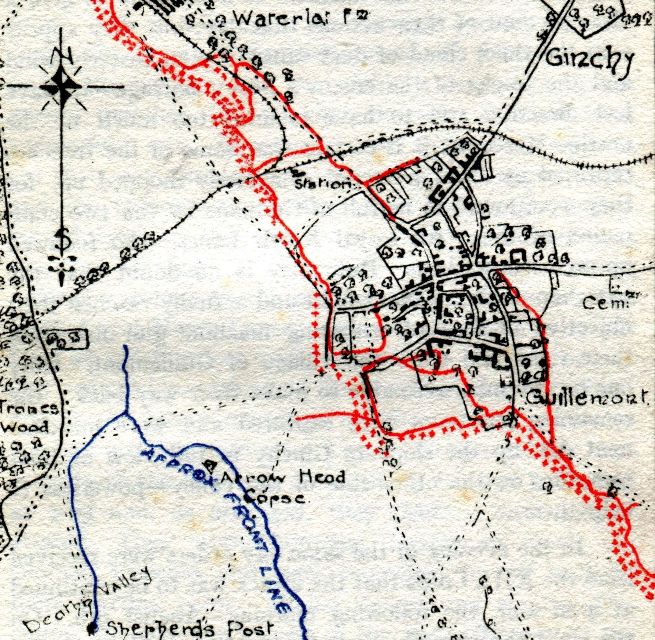 8/8/16: Killed (Other ranks) 10; Wounded: Officers 1 and ORs 47; Missing: Officers 13 and ORs 502 [War Diary 1/8 KLR]
8/8/16: Killed (Other ranks) 10; Wounded: Officers 1 and ORs 47; Missing: Officers 13 and ORs 502 [War Diary 1/8 KLR]
Although 164 Brigade made attempts to relieve 1/8 KLR, including planning a single-battalion night attack by the Lancashire Fusiliers, XIII Corps decided on a full fresh attack by 166 Brigade the next morning. Chaos ensued as brigades were relieved in line whilst assault troops moved up trenches still jammed with the wounded: trenches were choked. In 166 Brigade, 1/5 LNLR’s CO was not briefed as his unit was supporting 164 Brigade. From the 166 Brigade diary:
8/6/16: In afternoon 166 Brigade gets verbal instructions … to attack GUILLEMONT in the morning …. All COs apart from 1/5 LNLR are sent for …situation roughly explained. [Additionally] … have to take over the line from 164 Bde. At 9:30 pm [just as battalions start out], [ordered] to halt and await orders. At 10:40 pm final orders received to attack 4:20 am. [At 10:40 pm battalions either on road or at camp]. Move off quickly as possible. Endeavour to get Operation Order out in time.
9/6/16: 166 Brigade … share HQ with 164 Brigade. With great difficulty battalions … get into position … whilst most officers had been round trenches, battalions … did not know the ground. Combined with [impossibility of issuing orders until] the very last minute, and trenches full of [various] troops who had attacked the previous morning, made [for] great difficulty. Very great credit due to all Battalion commanders for getting … into strange trenches in time. [WD HQ 166 Bde]
Not ‘all’ battalions arrived on time. 166 Brigade attacked at 4:20 am with, on the right, the 1/10 KLR south of the Trônes Wood – Guillemont road, followed by 1/5th South Lancs [1/5 SLR]. The 1/5 LNLR were supposed to be on their left, north of the road. In 1/10 KLR.
9/8/16: At 3:40 am detailed orders for the attack were received [by 1/10 KLR]. Only 5 of 17 promised guides appeared to meet the Battalion …. All knew Battalion HQ but not the trenches. CO accordingly collected OC Companies and gave what little information was possible [in the time] while Acting Adjutant got Companies into position at 4:10 am. Artillery barrage started whilst last Company and Machine Gun Company were passing Battalion HQ which had just relieved 1/4 KORLR. At 4:23am first wave of V Company moved off in good order right behind our barrage as it lifted. [Adjutant’s Journal]
The ‘Scottish’ met uncut wire just short of the enemy line. The CO led two attempts until himself wounded. There were a further two efforts, breaking-in at two places, followed by withdrawal. On the left, there were even more serious problems. The CO of 1/5 LNLR (having been left out from his brigadier’s briefing on the previous afternoon) and his battalion were struggling:
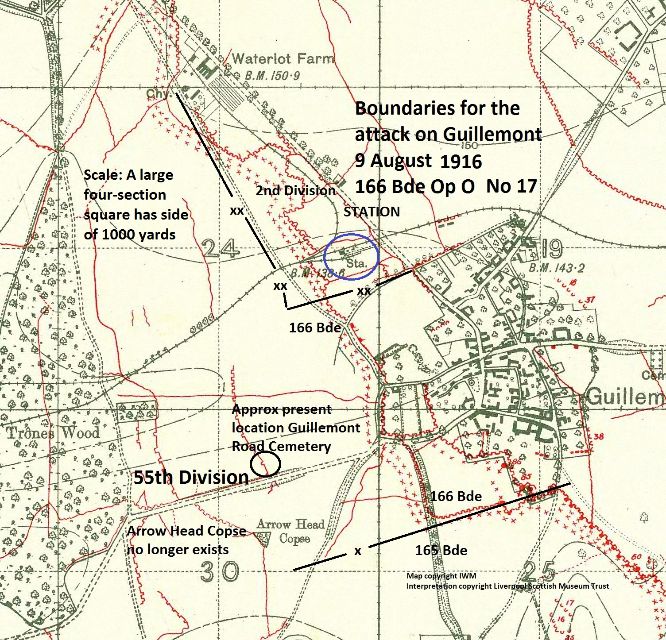 9/8/16: The Loyal North Lancs which was intended to attack at 4:20 am … was unable to get into position until after 5 o’clock [WD HQ 55th Division Narrative]
9/8/16: The Loyal North Lancs which was intended to attack at 4:20 am … was unable to get into position until after 5 o’clock [WD HQ 55th Division Narrative]
9/6/16: 1/5 LNLR were late in getting up into line, having had various orders from both brigades, and not having received the final orders until 2:30 am. They attacked about 5 am [War Diary 166 Bde]
They were 40 minutes too late to receive their artillery support.
The diary of Edmund Herd, stretcher bearer [SB] of the Liverpool Scottish, who won the Military Medal at Guillemont records:
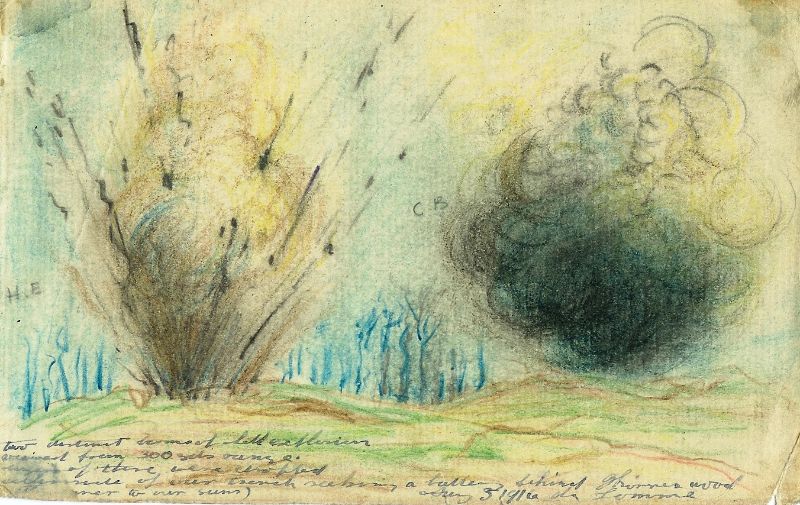 9/8/16: Attacked …short but terribly intense bombardment … hundreds of guns. Attack failed. [Three attempts] to take German trench but men mown down by MGs. Colonel wounded… Many friends … killed or missing. Busy time for SBs. Completely exhausted after severe and ghastly work. Buried for a short time but got out …. Spent what seemed endless time in a shell-hole with two wounded. Escape seemed impossible … machine gun was ranged on the spot but eventually … I got out with one of the men … and half-dragged him to where … some tin hats were moving. It [was] a sunken road … distance was not more than 50 yards, it seemed to be miles …being all the time fired on. [When] darkness fell, not so dark really with the hundreds of Very Lights, all SBs went out to bring in wounded and dead. … during night-search we took what cover we could from shrapnel and machine guns - only one casualty among SBs - the Doctor- who got a piece of shrapnel in his thigh. [Herd Diary]
9/8/16: Attacked …short but terribly intense bombardment … hundreds of guns. Attack failed. [Three attempts] to take German trench but men mown down by MGs. Colonel wounded… Many friends … killed or missing. Busy time for SBs. Completely exhausted after severe and ghastly work. Buried for a short time but got out …. Spent what seemed endless time in a shell-hole with two wounded. Escape seemed impossible … machine gun was ranged on the spot but eventually … I got out with one of the men … and half-dragged him to where … some tin hats were moving. It [was] a sunken road … distance was not more than 50 yards, it seemed to be miles …being all the time fired on. [When] darkness fell, not so dark really with the hundreds of Very Lights, all SBs went out to bring in wounded and dead. … during night-search we took what cover we could from shrapnel and machine guns - only one casualty among SBs - the Doctor- who got a piece of shrapnel in his thigh. [Herd Diary]
The ‘Doctor’ in this case was Noel Chavasse, awarded his first Victoria Cross in this action, saving the lives of over 23 wounded lying out.
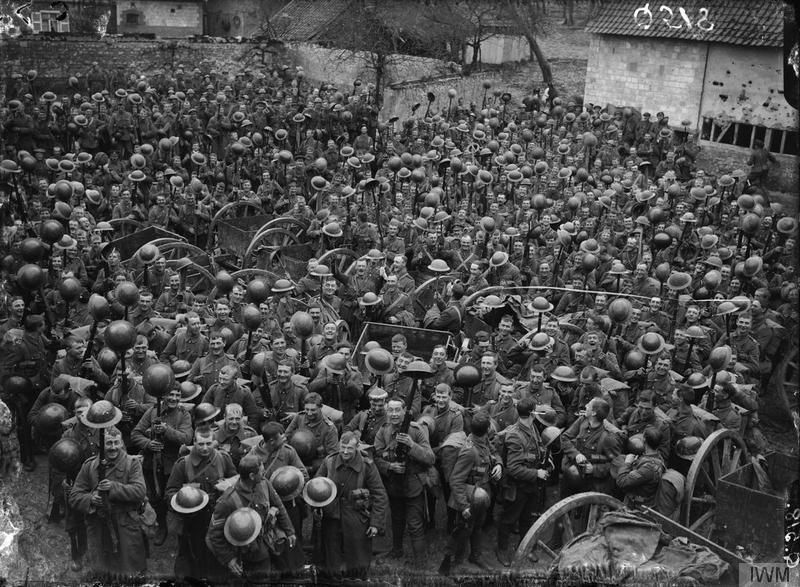 Before this attack had even happened, the 55th Division had been warned for an attack with the French, south of Guillemont, to take place on 12 August involving 165 Brigade, 1/9 KLR and William Campbell, finding great support in his religious faith, wrote:
Before this attack had even happened, the 55th Division had been warned for an attack with the French, south of Guillemont, to take place on 12 August involving 165 Brigade, 1/9 KLR and William Campbell, finding great support in his religious faith, wrote:
8/8/16: Greatcoats given in …everything indicates we are going over the top. Well, it is a moment to look to. I leave it all and trust in God. Many have lost their lives in a similar way in this war …. If the worst should happen… I only hope those to who I am dear will be consoled with the fact that I do it with a good heart and trust in God.
12/8/16: Carry bombs, 2 boxes. An agony march. Trenches narrow. … Arrive in reserve trenches greatly fatigued. Oh the sights I have seen …a haze of drama, murder. I have been over the top in a charge. It was hell. How any man lived through it is a mystery. My feeling before going was beyond words. … To portray the charge is impossible. I wish to God I could forget it all. I am safe. Many of my pals are no more.
15/8/16: During last few weeks I have seen sights enough to send a man crazy. To see one’s pals die, bleed to death, has provoked an earnest desire to understand it all. A belief, a support in some way is what I have craved for, prayed for. … Deaths on all sides and the stench of the dead! The very trenches seem to be built with dead men. [Campbell Diary]
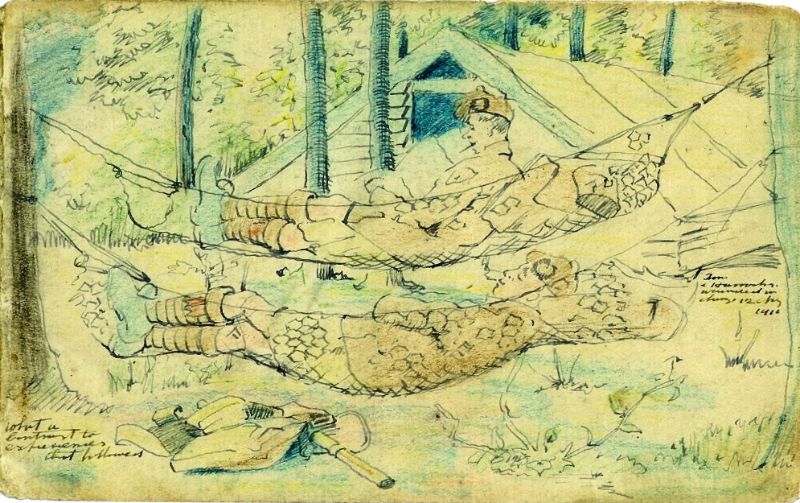
Shortly after this, the 55th Division goes into reserve, to re-equip, reorganise, retrain, and absorb new drafts of men. Considerable time was spent trying to learn the lessons of the early Somme campaign, drawing on their own experience and that of other divisions. They were back in action in September at Flers (near the scene of the first deployment of tanks) and Guedecourt, both east of Guillemont, which did not fall into British hands until the beginning of September.
Further reading:
The Story of the 55th Division 1916-1919 by The Rev JO Coop: Brief and uncritical Regimental histories listed at the expanded version of this article and more detailed
Acknowledgement: Mrs Brenda Giblin, for her painstaking work in transcribing the Campbell diary.
Ian Riley, Liverpool Scottish Museum Trust
Previous page: The West Lancashire Division Reforms
Next page: Digging for Victory
